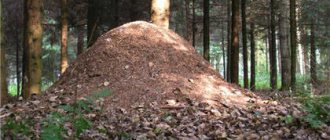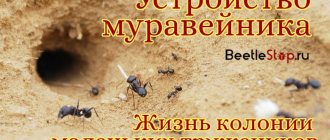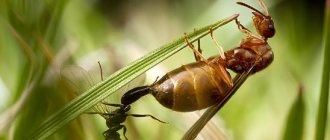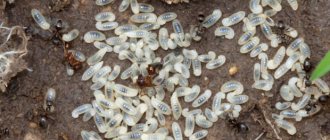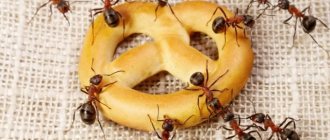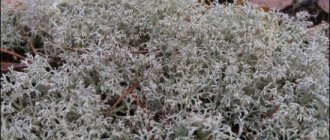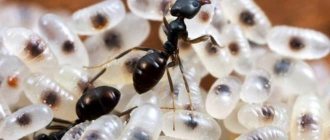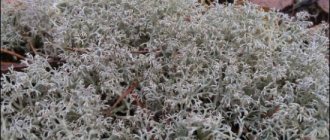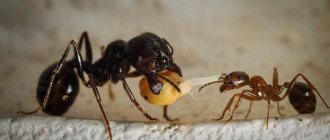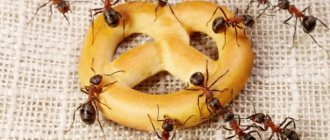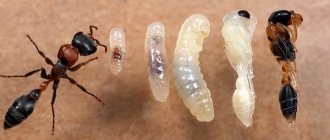Ants live everywhere
: They live in forests, fields, deserts and cities all over the earth. But what is the secret of their success? Like bees, ants are social animals. They live and work together in well-organized communities called colonies. In fact, most ant colonies are so united by the common goals of survival, growth and reproduction that they behave like a single organism, or “superorganism.” Next, we will learn more about the family (colony) of ants, tell you about the anthill (nest), about the queen and workers, and many more interesting things about the ant colony.
Just as an individual ant has different body parts that work seamlessly together, the ant superorganism
comprises anywhere from several tens to several million members of a colony who work together to achieve extraordinary results. This social behavior gives ants a great advantage over solitary insects (for example, dragonflies, European mantises) and other animals. Let's take a sneak peek inside the secret society of ants - a superorganism (ant colony).
Ant colony - a society of social insects
Ants always put the interests of their family first. Each colony is a close-knit family, and usually includes a mother (queen), her adult daughters (workers) and brood (eggs, larvae, pupae). During the mating season, new queens and males may also be in the colony, but not for long. These different types of ants represent stages of a complex individual life cycle.
In addition, ant superorganisms undergo their own sequence of changes called the colony life cycle. The smallest ant colonies include a queen and just a few workers. The largest colonies are home to many millions of workers, such colonies are more densely populated than any human city!
Relationships and communication of ants
Among these small insects there is a peculiar struggle for power. For example, in colonies of red ants, cases of capture of settlements of another species were observed. The queen queen finds a colony of black or forest relatives weakened due to an attack and takes the place of the dead queen. She then lays eggs, and when the red ants hatch from them, they actually enslave the colony of another species.
The opposite situation also occurs. During an attack from one anthill to another, the soldiers steal the eggs of their opponents and take them to themselves. After hatching, the insects become servants and work all their lives for the benefit of someone else’s colony. The life of many species of tropical ants is built on this principle: for example, Amazon ants are exclusively engaged in attacks on neighbors and capturing larvae; all the hard work inside their home and maintenance of life occurs only at the expense of slaves.
In nature, the opposite situation can be observed, when working individuals of neighboring anthills establish contact and exchange food. This is a kind of message to neighbors about peace and a proposal to unite into one colony.
This is how interesting the anthill is designed - it is an amazing structure with a complex organization, reminiscent of a big city. How much time and labor does it cost these tiny insects to rebuild an ant colony, the above-ground part of which is at every moment under threat from predators or natural phenomena.
Home sweet ant home
Ants build their homes in all sorts of places. Many species dig underground nests or build mounds of soil. Others live in fallen leaves, acorns, or rotting wood on the forest floor. Some ants prefer to take refuge under rocks, which can also provide warmth. There are even ants that nest only in trees. These insects are excellent architects, and their nests are designed to provide the right environment for the larvae to grow. Some nests even have a built-in ventilation system to circulate fresh air. To watch ants build a nest, you can keep them in an anthill.
What is it and how does an anthill appear?
When people talk about an anthill, they most often mean only a ground structure, without imagining what it really looks like. Experts include in this concept the underground part, passages and all inhabitants of the nest.
Most often, a new anthill begins with a young queen ant that has taken off on her only mating flight. After fertilization, she begins to look for a place to lay eggs. At first, the future queen takes care of the offspring herself, even refusing food. But everything changes as soon as the larvae turn into adults. Some ants begin to build an anthill, since they need shelter for winter. Some go for prey, others start caring for the queen.
Working individuals
You can understand what an anthill is made of by observing what hardworking insects drag into the house: twigs, leaves, bark, pieces of earth. All this is carefully glued together with a special compound produced by ants.
At first, the diameter of the future house is small, but work on its arrangement is carried out intensively and stops only for the winter. With the first warm days, little workers will again begin to expand their living space not only upward, but also into the depths of the earth.
The Queen and the Workers: Their Duties
Colony of ants
resembles a factory. Colony brothers work together to convert resources (food) into products (more ants). This process is characterized by a very efficient division of labor, just as different people have different specialties and positions in their jobs.
The queen has a very specific role of laying eggs, and spends most of her life performing this function. Worker ants
perform other duties, often depending on their age. Younger ants work inside the nest, caring for the queen and her brood. Older workers leave their homes to collect food and protect the nest from enemies. Despite her size and royal title, the queen does not lead the workers around her. Workers decide which tasks to perform based on personal preferences, interactions with fellow colony members, and cues from the environment.
How is the inside of an anthill arranged, what is its structure?
Sectional diagram of the structure of an anthill with the designation of functional chambers.
Structure of an ant colony. Most often, dome-shaped anthills are found, but sometimes ants prefer to settle in rotten tree trunks or large old stumps. In regions with extremely hot climates (for example, deserts), insects build their homes exclusively underground.
The inside of an anthill looks different, but the structure of the allocation and organization of specialized chambers is characteristic of any nest of ants.
Indoor cameras can be divided into the following categories:
- “ solarium ” - a small chamber under the very dome of the anthill, insects bask in it in the warm season;
- “ wintering chamber ” - located below the soil level, in which the ants survive the cold, plunging into suspended animation;
- “royal chamber” or “ queen’s room ” - here is the queen who lays eggs;
- “grain barn” or “ granary ” - intended for storing grass and tree seeds;
- “kindergarten” or “ nursery ” - chambers in which eggs mature and ant larvae are born;
- “meat pantry” or “ refrigerator ” - they store the corpses of insects, worms and caterpillars.
- “cow barn” - where ants contain and raise aphids.
- " graveyard " is a place where waste and deceased individuals are found. It is significantly removed from the anthill, since the ants understand that corpses and waste are a source of disease and infection;
Each sexually mature insect has a clear idea of the location of the chambers. An increase in the anthill leads to the expansion of existing chambers and the construction of new premises.
The depth of the anthill underground can reach up to 2 meters and has an organized complex structure. And the above-ground part can be from 30 cm to 2 m high. All this looks like a huge city.
The depth and structure of an ordinary anthill are amazing. The insides of this amazing structure consist of large fragments of branches. Between them there are many galleries leading to individual chambers, which is a rather complex device.
The height of the structure varies from 30 cm to 2 m, the underground part most often exceeds the above-ground area. The outer covering consists of small twigs, pine needles, grains of sand and reliably protects ants from dampness, wind and cold. The structure of the underground anthill of the garden ant is similar to the forest one, but on the surface it is only a small sandy mound.
Here are a few photos of what a large forest anthill looks like:
The underground part, as a rule, is comparable, and often exceeds the above-ground part in size. In places where there are large reserves of resources for ants (water, cereals, insects of other species), dwellings can reach gigantic sizes. In some cases, the population of a colony can exceed, imagine, 1.5 million individuals.
The anthill is arranged in an interesting way: up to a third of the working ants continuously move needles and branches! Why are they doing this?
The anthill is designed in such a way that a positive temperature (26-29 degrees Celsius) is constantly maintained inside, which is very important for ants. For this purpose, pine needles and branches from the lower layer of coating are transferred to the surface, ventilated and dried. This process is continuous, and approximately a third of the worker ants participate in it. Thanks to their efforts, favorable conditions are created for the development of larvae and the preservation of food supplies.
Communication skills of ants
Members of an ant colony can "talk" to each other to coordinate their activities, but they never make sounds. Ants communicate primarily through chemicals released from their antennae. Workers release pheromones with specific messages such as "Follow me to the food!" or “Intruder attack!”
Members of the same colony recognize each other through chemicals that coat their bodies. Each queen is coated with a unique mixture of chemicals that detect its presence. In addition, ants can also use touch and vibration to communicate in some situations.
Insect interaction - ant communication
We humans interact through speech, gestures, and facial expressions, but ants do not have this opportunity. They communicate in various ways, the simplest of which is tropholaxis - food exchange . Foraging ants (they are called foragers) bring a certain amount of food to the anthill. Each ant takes the required amount of food for itself, and then passes it on to the other ants. But this method of communication is not suitable for interspecies communication. Another way of communication is through smell. Each ant has its own smell, which is unique. In addition, each ant family has its own shades, which makes it possible to determine the entry of a stranger by smell. And finally, ants communicate using pheromones. They use them mainly to indicate the location of food or to warn of danger (anxiety pheromone).
Ant and a drop of water
City of Ants | Documentary
Two thousand heads are better than one
Each ant has a tiny brain. But all the ants in the colony are quite smart. Ant superorganisms can solve complex problems by processing information in groups. For example, a colony may compare potential nest sites before collectively selecting the best one. A single insect is not able to “weigh” a large number of options and may make a mistake.
Life of ants in an anthill
Each ant colony, regardless of species, has one or more queens. This is a large, sexually mature individual; the characteristic difference is its large transparent wings. They are necessary for searching for males; immediately after successful fertilization, the need for them disappears and they disappear.
The lifespan of a queen is from 3 to 6 years, which is almost twice as long as that of an ordinary worker. There are cases where the queen lived up to 20 years, while insects live longer in regions with temperate climates. Male drones live the shortest, their lifespan is no more than a month. After fertilization of the uterus, they are killed as unnecessary. (Learn more about how long ants live)
The fertilized queen lays eggs in the lowest and most extensive chamber of the anthill, located deep underground. And the size of an anthill underground can reach up to two meters! This is necessary to protect the offspring from predators, temperature changes and other dangerous factors.
The queen's lifestyle is different for each species. Thus, wild forest ants have several hundred young unfertilized females in their colony. After mating, females lay clutches throughout the forest, and new colonies form next to them.
The ants of a colony located next to a person always contain several dozen male drones. The overwhelming majority of the population consists of underdeveloped females. In a small colony there is only one queen, who carries out procreation.
If the conditions in a house or apartment are favorable (warm, damp, unsanitary), then the number of ants quickly increases. In this case, several new queens appear that are capable of reproduction, which enhances the development possibilities of the colony. These females do not form new colonies, but remain part of the existing one. Of course, as the number of queens increases, the spread of ants around the house accelerates.
Ant farms
Other ants are farmers leading a peaceful lifestyle. For example, leaf-cutter ants collect plants to plant special nutritious mushrooms inside their nests. Some ants resemble ranchers in their lifestyle. They keep herds of insects that suck plant sap (such as aphids) like livestock, and feed on the sweet syrup that their bodies produce when processing plant sap. Thus, ants, like people, are engaged in agriculture and raising livestock.
How does an ant colony work?
Sometimes a colony of these insects is considered a single organism endowed with a collective intelligence, they work so harmoniously. Ants do not live alone, and therefore, in order for a large family to exist successfully, responsibilities in the anthill are clearly divided between individuals.
Main roles:
- Queen or queen. Its job is to lay eggs.
- Male drones. They live shorter than all other relatives. Their purpose is to fertilize new queens, who will most often found their own anthills.
- Builders are busy all the time. They dig new passages and tunnels, carry building materials, repair the anthill, and monitor the microclimate inside the nest.
- Foragers. They are responsible for providing food to the entire colony. These jobs employ the largest number of adult individuals. They are the ones who drag the seeds of plants and insects into the anthill. They are good at working in a group if the prey is too large for one.
- Invaders are the most aggressive of all ants. Their task is to develop new territories and attack neighbors.
- Guards are constantly on duty at the entrances to the nest. They are the ones who control that no strangers dare to get inside.
- Nannies constantly take care of the eggs, feed the larvae, monitor the temperature, and, if necessary, drag the babies to the solarium and back.
- Paramedics help wounded and sick brothers. They also perform amputation operations, gnawing off the patient’s injured limb.
- Shepherds breed aphids and collect honeydew.
- Carriers and storekeepers distribute food into chambers and monitor their safety, if necessary, pulling them to the surface to dry.
Ants go to war
Ants are very loyal to their own colony, but they can be quite hostile towards outsiders. Competition among colonies for food and other resources often leads to aggression. Many species guard an established territory around their nest, which is outside the boundaries of neighboring ant colonies. If the territory is invaded by members of a rival colony, war may break out. During these battles, worker ants sometimes sting or bite rivals to death. Thus, the worst enemy of ants is not people, but other ants.
Anthill structure
An anthill in appearance resembles an ordinary mountain of branches, blades of grass, pieces of earth, but in fact it is a subtly and well-thought-out dwelling, the inside of which is much more interesting than the outside.
The ant house has a cone shape for a reason; thanks to it, the rain rolls down the blades of grass and needles almost without getting inside. The anthill rises above the level of the grass so that the sun's rays penetrate inside, which warm the ants and also warm their larvae and pupae. And the deeper layers of the anthill provide a refuge for insects on cold days. Thanks to a clever design, the ants spend the summer in the summer cone and winter in the earthen passages.
Parts of an ant's home
Looking at the picture, you can see the different parts of the anthill; below is what each of them serves:
- The top covering, consisting of needles, blades of grass and twigs, protects the ant house from weather conditions.
- A chamber heated by the sun's rays - here the ants warm themselves and their offspring.
- One of the many entrances, guarded by soldiers, in addition to serving as a door, also serves as a channel for ventilation.
- Storage area for garbage and dead ants.
- A wintering chamber where ants wait out the cold in a half-asleep state.
- Chamber for storing grains.
- The queen's chamber is where the queen lives and lays eggs, and is tended by worker ants.
- Chamber for eggs and larvae.
- Chamber for aphids.
- Storage room for caterpillars and other “meat” prey.
This is interesting! The largest anthill in the world is located in the Tomsk region near the village of Zavarzino. This conclusion was reached by Tomsk local historians who took measurements of this structure. In order to build such an ant house, the ant family, according to scientists, took at least 20 years. Record parameters are 3 meters high and 5 meters diameter. According to local historians, this anthill is becoming overgrown, but its residents have already started building a new home nearby. It is possible that it will not be inferior in size to the old one.
Anthill in the house
Sometimes ants from the wild begin to move into human homes. Destroying them can be very difficult, since finding an anthill is not always so easy. Most often it is located between the ceilings, where it cannot be reached.
To combat these insects, both chemical and traditional methods are used.
Gels and crayons are good because the ants carry toxic substances on their legs to the nest. The product is used to treat baseboards and main paths. Dohloks, FAS, Mashenka and Blockbuster pencils help a lot .
Sprays and aerosols are used if you manage to find an anthill. The products Raptor, Dichlorvos, Karbofos are sprayed directly into the nest.
Of the folk methods, the most effective is the use of boric acid . It is mixed with sugar syrup and dripped onto the substrate.
